- Home
- James L. Swanson
Chasing King's Killer Page 5
Chasing King's Killer Read online
Page 5
James Earl Ray had done it. He had escaped from one of the toughest prisons in the United States and had now survived his first week of freedom.
Ray was not an important criminal. He was not a notorious murderer, kidnapper, bank robber, counterfeiter, or mobster. Authorities did not publicize his escape widely and offered only a small, routine fifty-dollar reward for his capture. The FBI did not place Ray on its Most Wanted list or distribute posters bearing his picture to post offices across the country. His escape attracted little attention from the public or the news media. There would be no nationwide manhunt for someone as insignificant as James Earl Ray. If he stayed out of trouble, he might enjoy the rest of his life as a free man.
Martin Luther King was unaware of this event. He had never heard of Ray. They had never met, and King would not have recognized Ray’s face. Although the escape of this minor criminal set off no alarm bells, it did set in motion the ticking of a clock that would take almost one year to wind down.
It put Martin Luther King, Jr., and an obscure escaped convict on a deadly collision course.
James Earl Ray was born in Alton, Illinois, on March 10, 1928. His father was an ex-convict who sometimes worked as a manual laborer. He was lazy, often unemployed, and frequently absent from home. He set a poor example for his firstborn son.
James’s mother was only nineteen when he was born, and she had eight more children after him. In 1929 the family moved across the Mississippi River to St. Louis, and in 1932 they relocated to the small town of Ewing, Missouri. James began with disadvantages. His family was poor and lived in primitive conditions. Things were as dismal as they had been at the end of the Civil War. Lowly birth, meager circumstances, bad influences, and his poor education put James Earl Ray on a precarious path from the start.
“Jimmy” Ray was exactly the kind of underprivileged child that Martin Luther King, Jr., wanted to help. He failed and had to repeat the first grade. He did not enjoy school and was often absent. His family was too poor to buy him new shirts, pants, or shoes, and he thought the other children made fun of him because he wore old, patched clothes. A teacher described him cruelly, saying he looked “repulsive.” School records described him as dishonest, “seldom if ever polite,” and one who “violated all regulations.”
When he was fifteen and had not advanced beyond the eighth grade, he dropped out of school. In 1944, when he was sixteen, he got a job at a tannery for a shoe factory, where he learned to dye animal hides. But, almost two years later, he lost that job when the factory downsized after the end of the Second World War.
In February 1946, Ray enlisted in the United States Army. After basic training, where he learned to shoot a rifle, he was shipped out in July to Bremerhaven, Germany, and served as a private in the military police for the American army in Allied-occupied Germany. He was not a good soldier: He got into fights and sold stolen goods. He even served three months in an army stockade for drunkenness and resisting arrest. On December 23, 1948, he was discharged for “ineptness and lack of adaptability to military service.”
Back in the United States, Ray needed to earn a living, but he was unmotivated and did not want to work for a paycheck. Instead, he went to California, and in 1949, he committed a burglary and was sentenced to eight months in jail. By this point, Ray had graduated to more violent crimes, committing armed stickups and bank robberies. He and his brothers banded together in a gang of armed thieves, as the whole family was as shiftless and allergic to honest work as he was. Sometimes Ray, one of his brothers, and his uncle (who was the family’s inspiration and criminal leader) were even incarcerated in the same prison at the same time. James’s uncle passed on his insider knowledge of how to survive and even thrive in prison.
Some families take pride in establishing a multigenerational tradition of farming, of military service, of mastering a trade, or of pursuing education. The Rays took perverse pride in their criminality, passing it down from one generation to the next. Like his relatives, Ray had street smarts, always with an eye for “the main chance.” In an era that made folk heroes out of Bonnie and Clyde, the most ruthless and celebrated bank robbers in the South, the Ray family was content to create a legacy of petty crimes of opportunity, deception, fraud, and burglary.
In 1952, James committed an armed robbery of a Chicago taxi driver, was shot by the police, and served nearly two years at the Illinois State Prison at Pontiac. In September 1954, he was arrested for burglary in Edwardsville, Illinois, and while free on bond in March 1955, he burglarized a U.S. Post Office, stole almost seventy blank postal money orders, and then forged the endorsements to obtain cash or goods. For that crime he was sent to the federal prison at Leavenworth, Kansas, until April 1958.
However, there was one type of crime James Earl Ray had never committed. No evidence suggests that Ray ever participated in political or racial violence or hate crimes. He never singled out a victim because of his or her race, nor was he part of the Ku Klux Klan. Like millions of poor whites in the pre-WWII South, Ray had grown up with the prejudices common to his time, class, and region. But he was not known to be a warrior battling on the front lines of racism, fighting against desegregation or equal rights. On those issues, he stood on the sidelines. Ray was a believer in just one cause: grabbing a quick buck in the easiest way possible. Ray had been arrested plenty of times. But there were many other times when he had gotten away with it. To this day, Ray remains a suspect in a number of unsolved bank robberies.
It would be hard to find a man who was less like Martin Luther King, Jr., than James Earl Ray. From birth, King was everything that Ray was not: highly intelligent, ambitious, well-educated, religious, charismatic, eloquent, hardworking, and committed to a moral cause bigger than himself. That commitment had made King into one of the most famous and admired men in the world, and a confidant of the president of the United States. It was as though King and Ray were from different planets.
In October 1959, Ray participated in the armed robbery of a Kroger grocery store in St. Louis, a crime that yielded him little money but had severe consequences. The robbery had netted him and his accomplice just one hundred and twenty dollars—sixty dollars each. Captured immediately and sentenced as a habitual criminal to twenty years in prison at Missouri State Penitentiary at Jefferson City—one year for each pitiful three dollars he had stolen—James Earl Ray seemed destined to sit out the rest of the turbulent 1960s and 1970s on the sidelines, behind bars, and isolated from mainstream American life.
By spring 1967, while still in prison, he had already missed the early achievements of the space program, including the flights of astronauts Alan Shepard and John Glenn; the assassination of President John F. Kennedy in 1963; and the election of President Lyndon B. Johnson in 1964. Languishing year after year in prison, Ray could only watch—but not personally experience—America as it was transformed by pivotal events and social movements: the escalation of the Vietnam War; the civil rights movement; the 1965 assassination of black Muslim leader Malcolm X; the birth of the antiwar movement; and the emergence of the women’s rights movement. He was like a fly frozen in amber as the world moved forward.
If James Earl Ray had served out his sentence and been released from prison in 1980, no one would have ever heard of him. By then, he would have been fifty-two years old, and he would have been no more than a bystander to the era, isolated from one of the most event-packed decades in United States history. And he would have been released into a radically changed America.
In 1967, however, his escape catapulted him into the maelstrom of the 1960s. He was thirty-eight when he escaped from Jefferson City. He’d been imprisoned for more than one-third of his life, and he’d served thirteen years in four prisons. His escape had opened up an alternative universe of possibilities and the chance to rewrite his destiny. Now he had a chance to create a new life and to experience firsthand the spirit of his time.
Would he do it? Or would he lapse into his old criminal habits?
To
survive on the run, Ray would need, more than anything else, money. Committing more crimes—even behaving suspiciously—might attract law enforcement scrutiny that could land him back in prison. But because there was no nationwide manhunt for him, he would be safe as long as he did nothing to call attention to himself. The popular weekly TV drama The F.B.I., which closed each episode by broadcasting the mug shot of a wanted criminal, was not going to choose him for this notorious honor. Ray was too bland and insignificant.
In fact, James Earl Ray possessed an important trait that proved invaluable in his life of crime. He was a kind of everyman with an average-looking face and a flat, unremarkable personality that was difficult to remember. He didn’t stand out. He had a face that could confound a witness. He was the kind of man who failed to make a vivid impression and who, witnesses would often say later, looked just like anybody else.
Still, to avoid exposure, Ray kept moving. He arrived in Chicago on April 30, 1967, and soon found work eighteen miles north in Winnetka, a wealthy lakefront suburb. From May 7 to June 25, he had a job at the Indian Trail restaurant, where one of the owners remembered him as “such a nice man.” She described Ray as “quiet, neat, efficient, and so dependable,” but also said “he seemed lonely and shy.”
Ray had fond memories of his six weeks at the restaurant. “Yes, I had a good job there, and I hated to quit. I was earning far more money than I ever had in my life.” He was making the princely sum of one hundred and seventeen dollars a week—nearly as much as the hundred and twenty dollars he stole in the armed robbery that got him a twenty-year prison sentence! But he was afraid to remain at the Indian Trail too long, fearing the FBI would discover that he was using a false name and someone else’s social security number. So he quit to keep moving, and drove to Montreal, Canada, in July 1967, where he adopted a different false name: Eric Starvo Galt.
He stayed in Canada for a little more than a month, but then went south to Birmingham, Alabama, arriving on August 25, 1967. There he bought a white Mustang car, and, in September, applied for a driver’s license under his new false name. What he would do with his new identity remained to be seen.
Ray next went to Mexico, passing through Acapulco on the way to Puerto Vallarta, where he stayed from October 19 until mid-November. He posed as a writer, toting a typewriter, notebooks, and camera equipment, and driving a flashy car. Ray enjoyed this time like a vacation. It was cheap to stay in Mexico, so Ray took advantage of his opportunities, visiting many places, socializing with women, and treating locals to rides in his Mustang. After a brief visit to New Orleans, he set off to California, arriving in sunny Los Angeles on November 19, 1967, where he rented a cheap apartment for the next two months.
Like many Americans who drifted to California in the 1960s, James Earl Ray was trying to reinvent himself. He tried but failed to enter the business of making amateur adult films. He bought good-quality camera equipment, but that scheme went nowhere. Next he enrolled in a mail-order course to learn to be a locksmith, a useful skill for a burglar. He also became obsessed with self-help books, optimistic pop psychology texts that promised their readers new and better lives for the price of a fifty-cent paperback.
At this point, Ray was forty years old. He was a lonely, single man with no ties to a stable community. Instead, he was part of a loose-knit world of bars, clubs, seedy rooming houses, and the people who frequented them. He was a neat but not flashy dresser. He kept himself well groomed. He hated to wear dirty clothes, so he had his garments cleaned once a week at the Home Service Laundry on Hollywood Boulevard. In conversation, he was vague, secretive, and nondescript. He kept his opinions to himself. In appearance and demeanor, he was average in every way. And he shared his life with no one.
Ray also became fascinated by hypnosis. Starting November 27, 1967, he consulted a clinical psychologist, Dr. Mark O. Freeman, who taught him self-hypnosis as a way to increase his self-confidence and his ability to accomplish things.
On the same day, Martin Luther King, Jr., was thinking about grander things. On November 27, 1967, he announced plans for a “Poor People’s Campaign” in Washington, DC, the following summer. King hoped to unite Americans of all races and from all parts of the country in a common cause to demonstrate for better lives and economic advancement.
James Earl Ray had no interest in cooperation between races. Instead, he volunteered at the George Wallace presidential campaign headquarters in North Hollywood. Wallace was the segregationist Alabama governor who had defied efforts to enroll blacks in the state’s schools. He was gearing up to run in the presidential election of 1968. His Hollywood outpost was on a shoestring budget and attracted an oddball following. Ray identified with Wallace’s antigovernment, anticommunist, racist, and pro-segregationist views. Ray studied hate literature. He supported the white-power majority government that ruled the African nation of Rhodesia, and he even thought of moving there to become a mercenary soldier.
In December 1967, Ray enrolled in ballroom dancing lessons at the National Dance Studios on Pacific Avenue in Long Beach, California. He learned the rumba, the cha-cha, and various popular dances. But he was socially awkward and did not mix with the other students.
Ray spent Christmas Eve of 1967 alone in Los Angeles. “I don’t remember anything about that Christmas,” he recalled. “Christmas is for family people. It doesn’t mean anything to a loner like me. It’s just another day and another night to go to a bar or sit in your room and look at the paper and drink a beer or two and maybe switch on the TV.” On New Year’s Eve, he drove alone to Las Vegas and watched strangers gamble and play slot machines at casinos. He slept in his car and then drove back to Los Angeles.
Ray seemed content to pursue life on the West Coast. The warm weather and the easygoing lifestyle welcomed people without a past and were attractive to a man who wanted to leave his old life behind.
Until now, nothing about his interests, behavior, or activities in the eight months between his April prison escape and the end of 1967 suggested that he was on a collision course with Martin Luther King. He was obsessed with himself, not with King. Like so many others dissatisfied with their lives, Ray wanted, in the pop psychology language of the day, to “find himself.” He wanted his old self to disappear—and he wanted to reinvent himself in a new and improved version. It was a common aspiration of many people who went to California in the 1960s. The state became a symbol of new freedom and opportunity, and a haven for lost and troubled souls. Tens of thousands of Americans made the journey there.
By the end of 1967, President Lyndon Johnson was fighting multiple wars simultaneously. In his dream to create what he called the Great Society, he joined the fight for civil rights and against poverty and racism. In Vietnam, he had sent several hundred thousand Americans into battle. And at home, he fought against critics who wanted to end that war. Civil rights demonstrators were no longer the only people who marched in the nation’s streets. Now they were joined by young college students who protested United States involvement in Vietnam. Opposition to LBJ was building.
As 1967 drew to a close, no one knew that the New Year would be one of the most explosive years in American history. And for Lyndon B. Johnson, Martin Luther King, Jr., and James Earl Ray, 1968 would change their lives forever.
For the United States, 1968 began with chaos. North Vietnam launched a surprise military attack to coincide with Tet, the Vietnamese New Year. The enemy struck at major points across South Vietnam, including behind American lines, and even penetrated the United States embassy in Saigon, the capital. Although the Tet Offensive was crushed, the attack stunned the American military and it increased public skepticism about the chances for success of the war effort. It also intensified Martin Luther King’s antiwar stance, and it hurt President Johnson’s popularity.
For James Earl Ray, 1968 began with introspection. On January 4, he inaugurated the New Year by consulting another hypnotist. This one offered him a “mental profile” and gave him more self-help books
for his collection.
The new year also began with an attempt to earn an honest paycheck. On January 15, 1968, he enrolled at the International School of Bartending on Sunset Boulevard. In the six-week course, he would learn the recipes for at least 112 cocktails. Instructor Tomas Reyes Lau recalled Ray as a good student, “a nice fellow with a slight Southern accent, very intelligent, with the ability to develop this type of service.”
A few days after enrolling, Ray booked a room at the low-rent St. Francis Hotel on Hollywood Boulevard.
On February 1, 1968, in Memphis, Tennessee, two city trash collectors died in a terrible accident, crushed by the compactor inside their own garbage truck. It did not make national news. It was a local tragedy, one that seemed unlikely to resonate outside Memphis. Nothing suggested that the accident would have worldwide repercussions. But, like a stone skipping across the water of a still lake, this event sent out ripples that would reach far beyond Memphis.
It would touch Martin Luther King, Jr., in a way that no one could have imagined.
Back in California, Ray completed his bartending course on March 2. He posed with Tommy Lau, holding his graduation certificate. At the ceremony, a photographer closed in to take a photograph. Ray tensed. It was one of the cardinal rules for an escaped criminal: Never pose for pictures. Just before the photographer snapped the shutter, Ray closed his eyes tight and held them shut until after the picture was taken. It was an old con man’s trick to make it harder for anyone who saw the photo to recognize him.

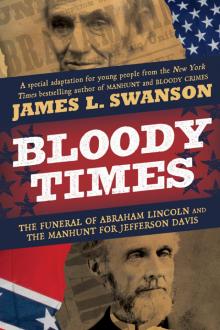 Bloody Times: The Funeral of Abraham Lincoln and the Manhunt for Jefferson Davis
Bloody Times: The Funeral of Abraham Lincoln and the Manhunt for Jefferson Davis Bloody Crimes: The Funeral of Abraham Lincoln and the Chase for Jefferson Davis
Bloody Crimes: The Funeral of Abraham Lincoln and the Chase for Jefferson Davis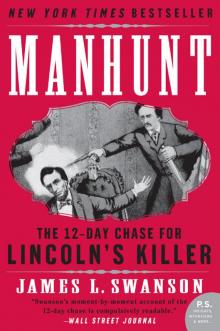 Manhunt: The 12-Day Chase for Lincoln's Killer
Manhunt: The 12-Day Chase for Lincoln's Killer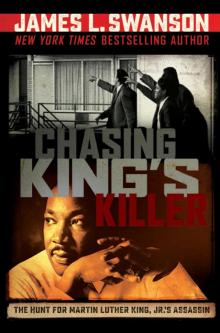 Chasing King's Killer: The Hunt for Martin Luther King, Jr.'s Assassin
Chasing King's Killer: The Hunt for Martin Luther King, Jr.'s Assassin Bloody Crimes
Bloody Crimes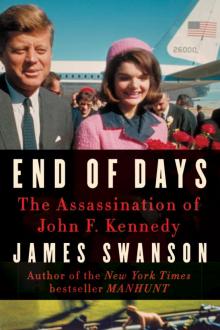 End of Days
End of Days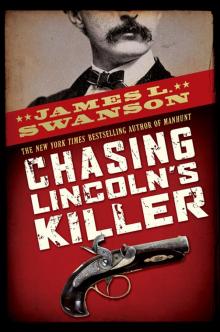 Chasing Lincoln's Killer
Chasing Lincoln's Killer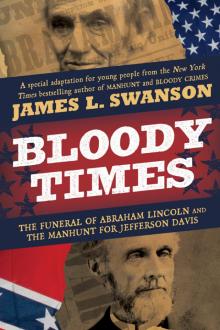 Bloody Times
Bloody Times Manhunt
Manhunt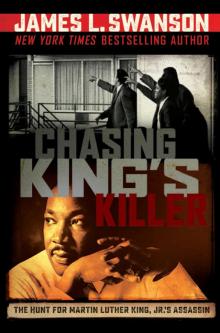 Chasing King's Killer
Chasing King's Killer